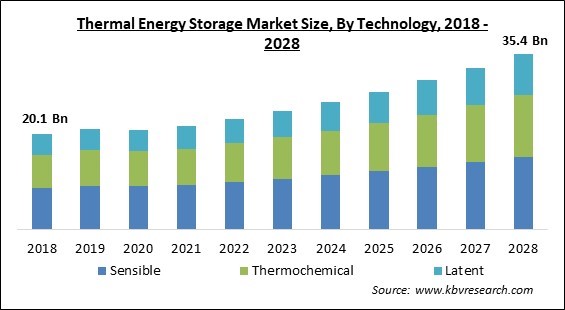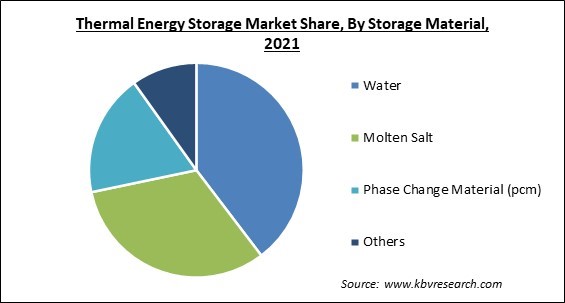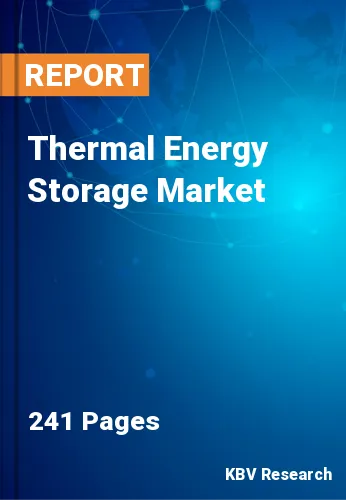The Global Thermal Energy Storage Market size is expected to reach $35.4 billion by 2028, rising at a market growth of 8.0% CAGR during the forecast period.
Thermal energy storage is a form of energy retention where different materials are employed to store energy when temperatures increase and lose energy as it falls. Heat pumps, heat generated by power plants, and waste are the most common sources of thermal energy storage. These energy storage devices minimize energy demand during peak hours, reduce carbon dioxide emissions, and reduce end-user energy usage. It's frequently used in thermal and solar power stations to provide dispatch able power even at night, as well as in process industries to use heat.
Thermal energy storage uses ice, cold air, or water to transmit and store energy for later use. It utilizes molten salt, ice, and emulsification gap alloy technology to store sensible, latent, and thermochemical heat. Some of these technologies are used to store hot or cold energy in order to power electrical systems in corporate and domestic buildings, while others are used to store solar energy in the summertime and then utilize it in the winter. This helps to prevent excessive use of conventional energy from grid systems.
Thermal Energy Storage systems have the potential to help humanity to achieve its goal of more reliable and efficient energy storage systems. The integration of value-added renewable energy with thermal energy storage systems opens up a world of possibilities for low-energy design and paves the path for a more sustainable society.
To overcome the solar resource's intermittency, concentrated solar power and its combination with thermal energy storage are critical. As a result, solar thermal power can be used during periods when there is no sunlight. The demand for energy storage is projected to expand as the acceptance of renewable energy grows. Thermal energy storage is safe, dependable, and environmentally benign. The thermal energy storage industry is expected to develop in the next years as a result of this.

Financing, policy uncertainty, and grid integration were already posing challenges to the utilization of renewable energy technology in numerous markets at the start of 2021, and COVID-19 has added to the mix of problems. According to the IEA, The COVID-19 crisis had a considerable negative impact on renewable power capacity increase and thus on the thermal energy storage market. The number of new renewable electricity projects is expected to decline in 2021, according to IEA forecasts, as a result of the greater international COVID-19 issue. For the first time in 20 years since 2000, annual renewable energy capacity has declined.
Decarbonization of the energy sector and carbon emission reductions to limit world climate change are among the most prominent priorities for governments, energy regulators, and corporations across the world. According to IRENA, accelerating renewable energy deployment, along with electrification and enhanced electric grid energy efficiency, can assist accomplish over 90% of the energy-related CO2 emission reductions required to reach the Paris Climate objectives by 2050. According to IRENA, the renewable energy capacity factor was 176 GW larger in 2019 than it was in 2018, a rise of 7.4%. Solar power continues to increase rapidly; in 2018, it surpassed biofuels as the third-largest source of renewable electricity. In 2018, solar and wind energy generation climbed by 28% and 11%, correspondingly.
A decentralized energy system is defined by the proximity of energy-producing facilities to energy consuming sites. A decentralized energy system makes better use of renewable energy and combined heat and power, minimizes fossil fuel consumption, and improves environmental efficiency. In most nations, a decentralized energy system is a comparatively recent approach to the power business. Typically, the power sector has focused on creating huge, central power stations and delivering generation loads to consumers in the region through extensive transmission and distribution lines.
Thermal energy storage costs vary depending on the requirements, size, and thermal barrier technique used. Thermal storage systems based on phase transition materials and thermo-chemical storage are frequently more expensive than the storage space value they offer. The price of storage systems accounts for roughly 30% to 40% of the entire system cost. Thermal energy storage solutions are expected to become more competitive eventually as research into energy storage technology continues to reduce the upfront capital requirement. Sensible heat storage has storage capacities ranging from 10 kWh/t to 50 kWh/t and storage efficiencies ranging from 50% to 90%, depending on the storage medium's specific heat and thermal insulation technology.

Based on Technology, the market is segmented into Sensible, Thermochemical, and Latent. The thermochemical segment registered a significant revenue share in the thermal energy storage market in 2021. The thermochemical heat collected by distinct substances is discharged when a counter-reaction occurs between them in this storage. When it is compared to latent or sensible heat storage systems, thermochemical storage systems have a higher energy density. This type of heat storage is better for long-term storage because losses only happen during the charging and discharging periods.
Based on Storage Material, the market is segmented into Water, Molten Salt, Phase Change Material (pcm), and Others. The water segment garnered the highest revenue share in the thermal energy storage market in 2021. Water is the most often used medium for storing heat energy since it has one of the hottest setting capacities of 4.2 J/(cms. K). It's used in a variety of applications, including heat storage tanks, stones, masonry, and hot rocks. The steam produced is then used to power turbines, which produce a reduced cost, high-efficiency electricity.
Based on End-user, the market is segmented into Commercial & Industrial, Utilities, and Residential. The utilities segment registered a substantial revenue share in the thermal energy storage market in 2021. As a realistic demand-side management tool, thermal energy storage technologies are implemented in electric utility plants. These systems store thermal energy in tanks using ice or refrigerated water technologies during off-peak utility hours. Moving consumer power demand to off-peak hours, helps meet maximum consumption with fewer power plants. Many utilities now offer customers time-of-day pricing, in which they sell power at a cheaper rate during off-peak hours. Broadband connection, natural gas, transportation, water, sewage, telephone, and electricity are all included in this category.
Based on Application, the market is segmented into Heating, Power Generation, and Cooling. The heating segment acquired the largest revenue share in the thermal energy storage market in 2021. Due to an increase in demand for heating and cooling purposes such as heating water, apartment heating and cooling, and in some cases to meet power generation needs. Furthermore, during the forecasted period, an increase in awareness of the pollution caused by traditional heating and cooling systems such as boilers, fossil fuels, and others is expected to fuel the desire for thermal energy storage.
| Report Attribute | Details |
|---|---|
| Market size value in 2021 | USD 20.9 Billion |
| Market size forecast in 2028 | USD 35.4 Billion |
| Base Year | 2021 |
| Historical Period | 2018 to 2020 |
| Forecast Period | 2022 to 2028 |
| Revenue Growth Rate | CAGR of 8% from 2022 to 2028 |
| Number of Pages | 241 |
| Number of Tables | 450 |
| Report coverage | Market Trends, Revenue Estimation and Forecast, Segmentation Analysis, Regional and Country Breakdown, Companies Strategic Developments, Company Profiling |
| Segments covered | Technology, Storage Material, Application, End-user, Region |
| Country scope | US, Canada, Mexico, Germany, UK, France, Russia, Spain, Italy, China, Japan, India, South Korea, Singapore, Malaysia, Brazil, Argentina, UAE, Saudi Arabia, South Africa, Nigeria |
| Growth Drivers |
|
| Restraints |
|
Based on Regions, the market is segmented into North America, Europe, Asia Pacific, and Latin America, Middle East & Africa. The European region procured the highest revenue share in the thermal energy storage market in 2021. The presence of a large customer base, quick expansion of the thermal energy storage industry, and the presence of significant businesses in the region are all factors contributing to this. Additionally, the presence of rising and growing economies like Germany, France, Italy, Spain, and the United Kingdom promotes a desire for thermal energy storage heating and cooling applications, which is expected to contribute to the market's growth in Europe.
Free Valuable Insights: Global Thermal Energy Storage Market size to reach USD 35.4 Billion by 2028
The market research report covers the analysis of key stake holders of the market. Key companies profiled in the report include Baltimore Aircoil Company, Inc.(Amsted Industries), Steffes, LLC, Dunham Bush Limited (Yantai Moon Group Co Ltd) (Moon Environment Technology Co., Ltd.), Evapco, Inc., SR ENERGY (SolarReserve), Caldwell Energy Company, Abengoa, BrightSource Energy, Inc., Terrafore Technologies, LLC, and Goss, Inc.
By Technology
By Storage Material
By End-user
By Application
By Geography
The global thermal energy storage market size is expected to reach $35.4 billion by 2028.
Energy storage is in high demand to support ever-increasing solar energy generation are increasing are driving the market in coming years, however, preliminary set costs are high depending on technology growth of the market.
Baltimore Aircoil Company, Inc.(Amsted Industries), Steffes, LLC, Dunham Bush Limited (Yantai Moon Group Co Ltd) (Moon Environment Technology Co., Ltd.), Evapco, Inc., SR ENERGY (SolarReserve), Caldwell Energy Company, Abengoa, BrightSource Energy, Inc., Terrafore Technologies, LLC, and Goss, Inc.
COVID-19 crisis had a considerable negative impact on renewable power capacity increase and thus on the thermal energy storage market.
The Sensible segment acquired maximum revenue share in the Global Thermal Energy Storage Market by Technology in 2021, thereby, achieving a market value of $14.6 billion by 2028.
The Europe market dominated the Global Thermal Energy Storage Market by Region in 2021, and would continue to be a dominant market till 2028; thereby, achieving a market value of $12.7 billion by 2028.
Our team of dedicated experts can provide you with attractive expansion opportunities for your business.

